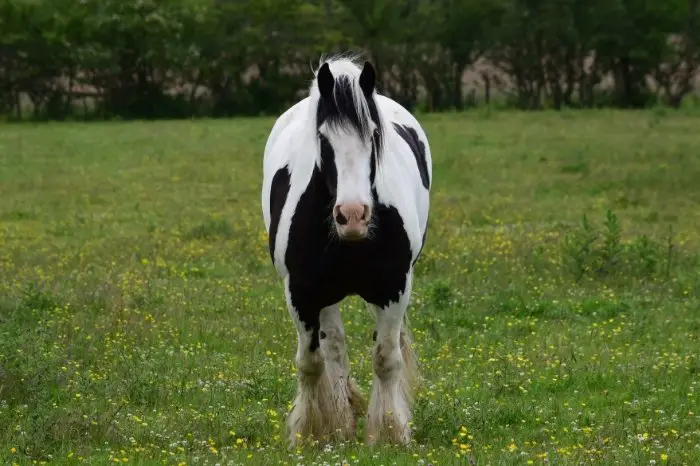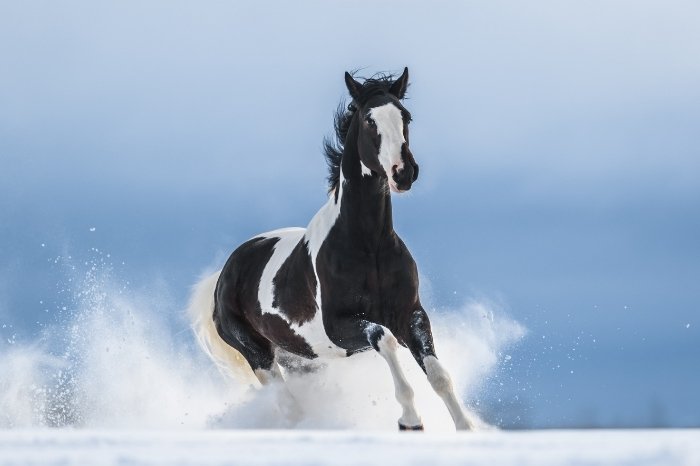Last Updated on January 26, 2022
Black and white horses are captivating and people have been drawn to them for centuries. Get to know some of these two-colored horses a little better with our top picks for the best black and white horse breeds.
Black And White Horses
White and black horses are increasing in popularity. There are many different types of two-colored horses, from those with small flecks of color to those that are evenly two-toned. The general term for these horses is ‘Pinto’.
So are these horses technically white with black spots or black with white spots?
Tobiano-colored horses are white and black (or another dark color) because of the tobiano gene they carry. These horses have a dark base color, and white patches over their flanks and back. Their mane and tail can also be a mix of colors.

Overo-colored horses are very similar to the tobiano coloring, except for instead of having white patches over their body, the patches are mostly found on their legs and face. Overo horses commonly have blue eyes as well.
Piebald horses are very common in breeds of all kinds today. This is a broad term to describe any horse who has both white and black coloring.
1. Gypsy Vanner – Black And White Horse Breeds
Gypsy Vanner horses, also known as Gypsy Cobs or Irish Cobs, are very well known throughout the world. These horses were bred in England and Ireland.
The Gypsy Vanner horses are most commonly piebald or skewbald, which is white patches on a coat that is another color than black. There is no coat color requirement for registration with the Gypsy Vanner horse society, as there are many variations of their coat.
One iconic feature of most Gypsy Vanner horses is their feathering, which is long hair on their lower legs. However, this is also not a requirement for a horse to be registered.
The Gypsy Cob horse was originally bred by the Romanichal Travellers to pull their Vardoes, or wagons that they lived inside of. They would travel across Great Britain in large caravans of horse-drawn wagons.
Gypsy Vanners, as we know them today, became to develop their distinctive characteristics after World War Two. Many horses at that time were considered unfashionable and were cast out. Among these horses included Shire draft horses and spotted horses. The Romanichal Travellers ended up with many of these horses, and by the 1950s they had bred them into a status symbol for their culture.
Today Gypsy Cobs are shown and traded at horse shows around the world. They can also be ridden and can be seen competing in several disciplines with other breeds of horses.
2. Appaloosa
Appaloosa horses are an iconic part of history, especially in America’s old west. They are very easily identified for their ‘leopard’ spots.
Their unique coat is the result of a genetic mutation called the ‘leopard complex’ mutation. It is hard to tell what color foals will end up, as all foals usually start dark and lighten as they mature. The leopard pattern may not show up on a young horse until many years have passed.
There are several variations of color patterns on Appaloosas. ‘Blanket with spots’ refers to a horse with a dark body, a white back, hips, and then dark spots over the white parts. Black and white thus are layered over each other with this coloring. Leopard-colored Appaloosas are white but have dark spots covering their entire body.
Prehistoric cave paintings have depicted spotted horses similar to the Appaloosa, showing that early feral horses had spots. Art dating back to Ancient Greece, Persia, and China has shown horses with the leopard complex genes.
The Nez-Perce people who lived in Oregon and Idaho are credited with making the appaloosa what it is today. They had spent years creating large breeding herds filled with horses who were strong and provided the support they needed for life in the west. They relied heavily on the fast, agile Appaloosa. Sadly, they lost most of their herd after a war in 1877. The horses were dispersed and some of them were even used in Buffalo Bill’s Wild West Show.
Appaloosas are used today in many different disciplines. They compete in many Western disciplines like cutting reining, and barrel racing, while also used in English riding as jumping and eventing competitors. Appaloosas are even bred as racehorses, commonly competing in middle-distance races.
3. American Paint Horse
The American Paint Horse Association (APHA) is the second-largest bred registry in North America. They are well known for their unique combination of white with black, bay, or chestnut patches. These patches can be any color, shape, and size, as long as they aren’t the pattern of the leopard complex, as this is characteristic of the Appaloosa.
Some people refer to these horses as both “paint” and “pinto” colored. What is the difference between these? “Paint” refers to the breed of horse. “Pinto” is the actual coloring of the horse.
Paint horses have close ancestry with Thoroughbreds and American Quarter Horses. Their body type is similar to the Quarter horse, having a smaller, muscular, stocky frame.

The APHA has strict requirements for registration. The Paint’s sire and dam must already be registered with the APHA, the American Quarter Horse Association, or the Jockey club, which registers Thoroughbreds. In addition to this, at least one parent must be registered with the APHA.
Paint horses are also used in a variety of disciplines but are most commonly found in western pleasure, reining, and barely racing events.
Multi-colored Horses
Horses that are black and white are very desired and popular today. Many people throughout history have worked hard to preserve their bloodlines and unique colors, and it shows in the broad range of coloring we see today.
